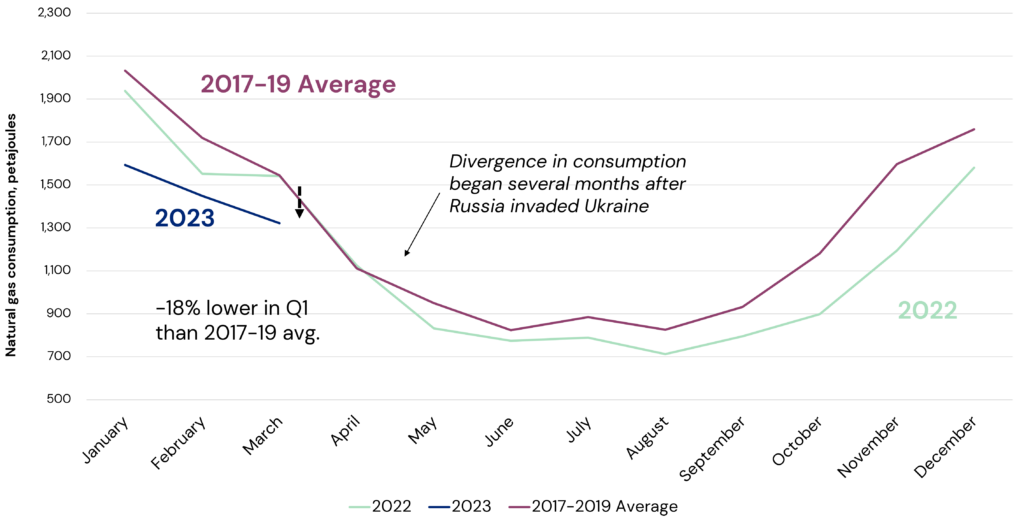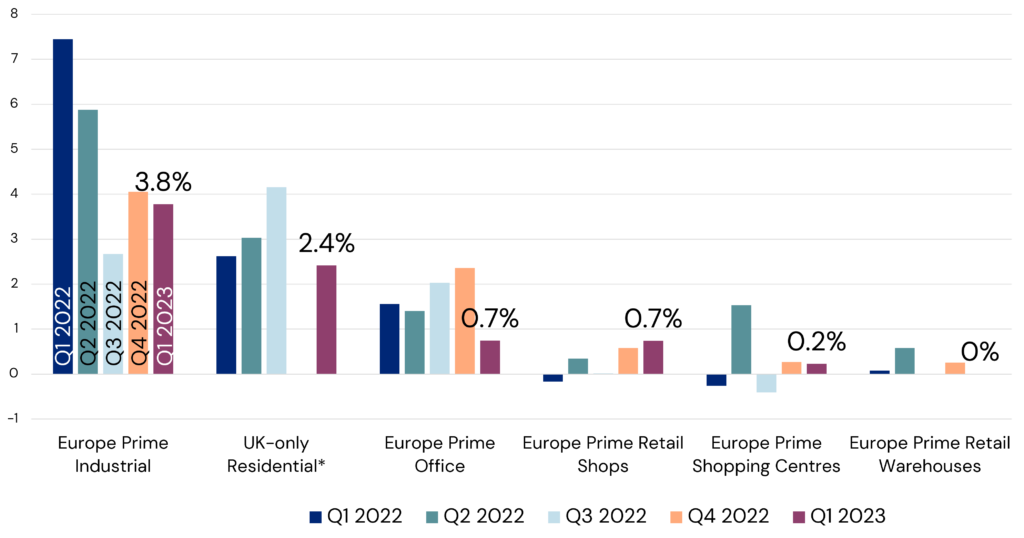-
The state of the market year-to-date: Capital markets digest repricing, as tenant demand stays resilient and energy markets deliver a positive surprise.
Our latest LaSalle European Market View shows how Europe’s economies and real estate markets are being impacted by, and adapting to, the current period of unusual uncertainty.
This update highlights recently released data on how Europe’s energy market has coped with shutoffs and surging prices in the winter following Russia’s invasion of Ukraine. It did so through a combination of reduced consumption (p. 6), more electricity generation from renewables (p. 7), and shifting to imports from new sources (p. 8). In Q1, the EU’s natural gas consumption was tracking 18% below average. This owes some thanks to mild winter temperatures, but also to conscious conservation efforts.
Natural gas consumption in Europe (EU27)

Source: LaSalle analysis of Eurostat data to March 2023. Note that the UK is excluded from all time series data above.
Falling energy prices have led to recent steep headline inflation declines (p. 11) and kept Europe’s largest economies from entering recession to date (p. 9). Yet core inflation – excluding volatile food and energy – is higher today than in 2022 – and GDP growth is at stall speed. European banks have weathered the aftershocks of SVB’s failure and the Swiss National Bank’s forced resolution of Credit Suisse. However, some pullback in bank risk appetite is evident in debt markets (see p. 29 and our April ISA Briefing).
Even as the ECB and Bank of England’s rate hikes have continued, long-term swap rates today are similar to where they started the year (p. 28). This has given private real estate and yields some time to digest the new repricing math. The UK’s repricing stands out for its speed, with monthly UK index data swinging to a positive return in March after eight months of deep negative returns (p. 34).
European real estate transaction volume declined to an 11-year low in Q1. This is a lagging rather than concurrent indicator, however, and reflects the high uncertainty and bid-ask spreads that existed near the end of 2022. At the same time, the most recent Q1 data on occupier trends shows hardy demand fundamentals, albeit with some cooling. In Q1, prime logistics rents continued to grow at a double-digit annualized pace and UK residential sector kept pace with high inflation across many markets, even as office rents cooled and retail rents were flat. As we look ahead, we believe the relationship between current vacancy and its historic levels (p. 18, 20, 21) points to the European property types and markets where rent momentum is most likely to continue.
Quarter-over-quarter rental growth in Europe

*Average rent and Q1 2023 residential data currently unavailable. UK residential rent data is based on new listings (rather than in-place rents).
Source: JLL, HomeLet data to Q1 2023. Latest as of May 2023.Want to read more?

Jul 01, 2025
PERE: Q&A with Global CEO Mark Gabbay
LaSalle’s Global CEO sat down with PERE to discuss the world’s simplest, most complicated asset class.




